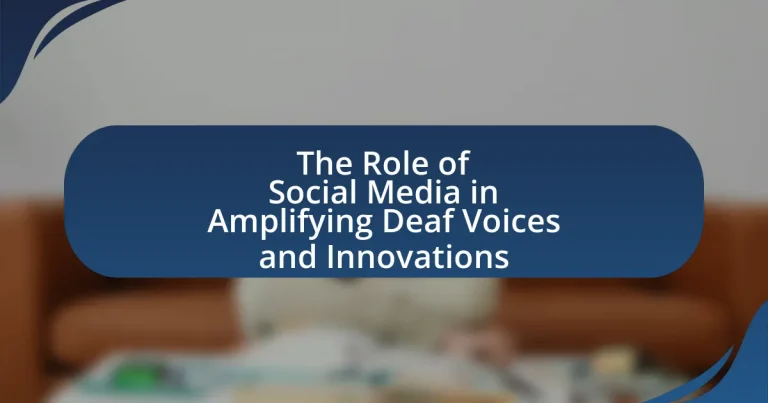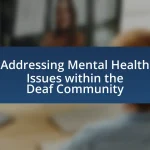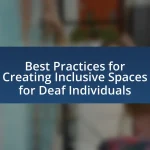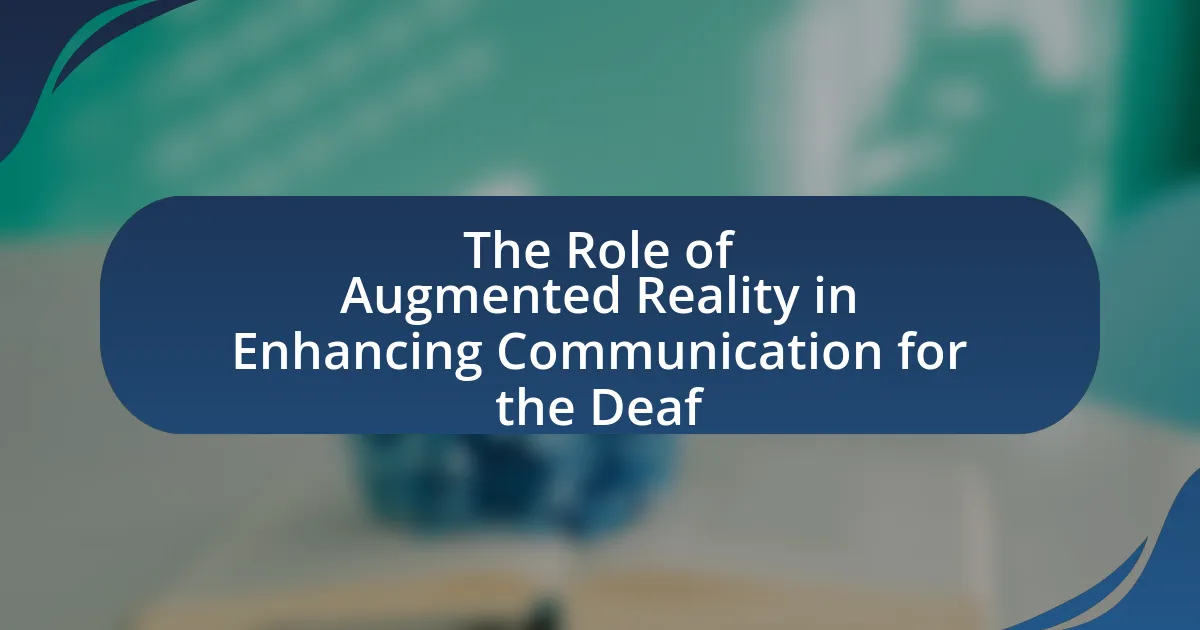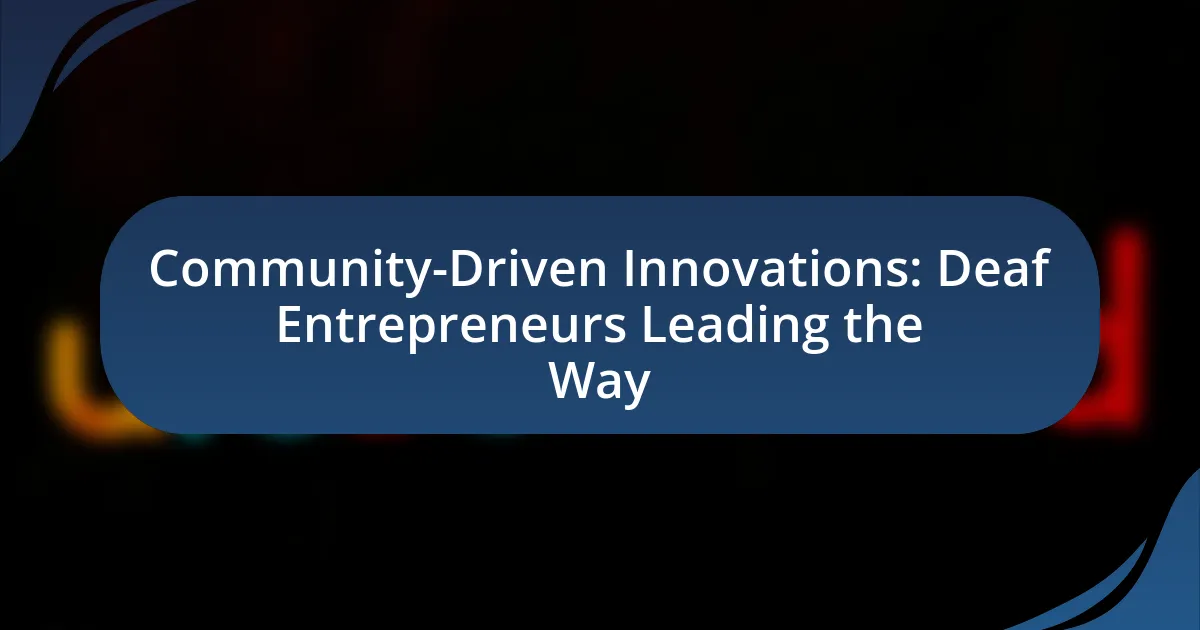The article examines the significant role of social media in amplifying Deaf voices and innovations, highlighting how platforms like Facebook, Instagram, and Twitter facilitate visibility, community building, and advocacy for the Deaf community. It discusses the benefits of social media features such as visual communication tools and captioning options, which enhance accessibility and inclusivity. The article also explores how Deaf individuals express their identities, challenge stereotypes, and engage in cultural exchange through social media, while addressing the challenges faced in representing Deaf culture online. Additionally, it outlines best practices for effectively sharing stories and increasing visibility within the Deaf community.
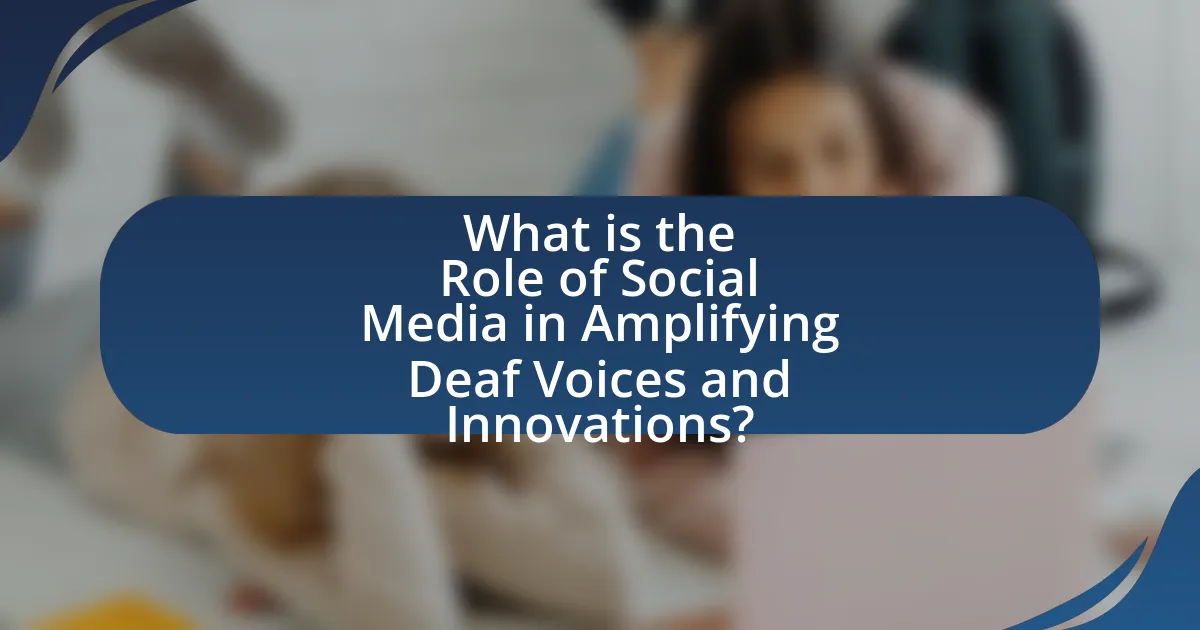
What is the Role of Social Media in Amplifying Deaf Voices and Innovations?
Social media plays a crucial role in amplifying Deaf voices and innovations by providing a platform for visibility, community building, and advocacy. Through platforms like Facebook, Instagram, and Twitter, Deaf individuals can share their experiences, promote awareness about Deaf culture, and connect with others who share similar challenges and triumphs. For instance, the hashtag #DeafTalent has been used to highlight the achievements of Deaf artists and professionals, showcasing their contributions to various fields. Additionally, social media facilitates the dissemination of innovative technologies and resources designed for the Deaf community, such as video relay services and captioning tools, which enhance communication accessibility. This interconnectedness fosters a sense of belonging and empowerment, enabling Deaf individuals to advocate for their rights and influence societal perceptions.
How does social media serve as a platform for Deaf individuals?
Social media serves as a vital platform for Deaf individuals by facilitating communication, community building, and access to information. It allows Deaf users to connect with others who share similar experiences, fostering a sense of belonging and support. Platforms like Facebook, Instagram, and TikTok enable the sharing of visual content, such as videos in sign language, which enhances understanding and engagement. Research indicates that 90% of Deaf individuals use social media to connect with their peers, highlighting its importance in their daily lives. Additionally, social media provides a space for advocacy and raising awareness about Deaf culture and issues, empowering users to amplify their voices and influence societal perceptions.
What features of social media are particularly beneficial for Deaf users?
Social media platforms offer several features that are particularly beneficial for Deaf users, including visual communication tools, captioning options, and community-building capabilities. Visual communication tools, such as video calls and image sharing, allow Deaf individuals to engage in sign language and express themselves visually, which is essential for effective communication. Captioning options on videos and live streams enable Deaf users to access spoken content in real-time, ensuring they do not miss important information. Additionally, social media fosters community-building by connecting Deaf individuals with shared experiences and interests, facilitating support networks and advocacy efforts. These features collectively enhance accessibility and inclusivity for Deaf users in the digital space.
How do Deaf individuals utilize social media to express their identities?
Deaf individuals utilize social media to express their identities by sharing personal stories, cultural experiences, and visual content that reflects their unique perspectives. Platforms like Instagram, TikTok, and Facebook allow them to connect with others in the Deaf community, promote Deaf culture, and advocate for accessibility and inclusion. Research indicates that social media serves as a vital tool for identity formation, enabling Deaf individuals to showcase their language, such as American Sign Language, and engage in discussions about their experiences. This digital expression fosters a sense of belonging and empowerment, as evidenced by the growing number of Deaf influencers who use these platforms to raise awareness and challenge stereotypes.
Why is it important to amplify Deaf voices through social media?
Amplifying Deaf voices through social media is crucial for fostering inclusivity and representation. Social media platforms provide a space for Deaf individuals to share their experiences, advocate for their rights, and connect with a broader audience, thereby challenging societal misconceptions. Research indicates that representation in media can significantly influence public perception and policy, as seen in studies highlighting the impact of diverse narratives on audience attitudes (e.g., “The Impact of Representation on Public Attitudes,” Journal of Communication, 2020). By elevating Deaf voices, social media not only promotes awareness but also encourages dialogue and understanding, ultimately leading to a more equitable society.
What impact does visibility on social media have on the Deaf community?
Visibility on social media significantly enhances the representation and advocacy of the Deaf community. Increased visibility allows Deaf individuals to share their experiences, culture, and language, fostering a sense of community and belonging. For instance, platforms like Instagram and TikTok have become vital for Deaf creators to showcase sign language, raise awareness about Deaf issues, and challenge stereotypes. Research indicates that social media campaigns, such as #DeafTalent, have successfully highlighted the contributions of Deaf individuals in various fields, leading to greater acceptance and inclusion in society. This visibility not only empowers the Deaf community but also educates the hearing population, promoting understanding and reducing stigma.
How does social media challenge stereotypes about Deaf individuals?
Social media challenges stereotypes about Deaf individuals by providing a platform for authentic representation and communication. Through videos, posts, and live streams, Deaf creators showcase their culture, language, and daily experiences, countering misconceptions that Deaf people are isolated or incapable of engaging with the hearing world. For instance, the rise of popular Deaf influencers on platforms like Instagram and TikTok has led to increased visibility and understanding of Deaf culture, including the use of sign language. Research indicates that social media can foster community and connection, as seen in studies highlighting how Deaf individuals use these platforms to share their stories and advocate for accessibility, thereby reshaping public perceptions and promoting inclusivity.
What innovations have emerged from the Deaf community on social media?
Innovations that have emerged from the Deaf community on social media include the widespread use of video content for communication, the development of sign language interpretation services, and the creation of platforms specifically designed for Deaf users. Video content allows for the effective use of sign language, enabling Deaf individuals to share their experiences and stories visually. Services like live captioning and sign language interpretation have become more accessible through social media platforms, enhancing communication for Deaf users. Additionally, platforms such as Deaf-owned social media networks have fostered community engagement and provided spaces for sharing resources, advocacy, and cultural expression. These innovations reflect the community’s adaptation to digital communication and their efforts to enhance visibility and representation online.
What are some notable campaigns or movements led by Deaf individuals online?
Notable campaigns led by Deaf individuals online include the #DeafTalent movement, which advocates for the representation of Deaf actors in media, and the #WeThe15 campaign, aimed at promoting the rights and inclusion of people with disabilities, including the Deaf community. The #DeafTalent movement gained traction through social media platforms, highlighting the lack of Deaf representation in film and television, and has led to increased awareness and opportunities for Deaf performers. The #WeThe15 campaign, launched in 2021, seeks to represent 15% of the global population living with disabilities, using social media to amplify voices and push for systemic change. These campaigns demonstrate the power of online platforms in mobilizing support and fostering community among Deaf individuals.
How do technological advancements in social media enhance Deaf communication?
Technological advancements in social media enhance Deaf communication by providing accessible platforms for visual and text-based interactions. These platforms, such as video sharing and messaging apps, allow Deaf individuals to use sign language and written communication effectively, bridging gaps in traditional communication methods. For instance, features like video calls enable real-time sign language conversations, while text-based posts and comments facilitate engagement in discussions without the need for auditory input. Additionally, social media algorithms can promote content relevant to Deaf culture and issues, fostering community and awareness. This accessibility and community-building aspect is crucial, as studies indicate that social media significantly increases the visibility of Deaf voices and experiences, leading to greater advocacy and representation.
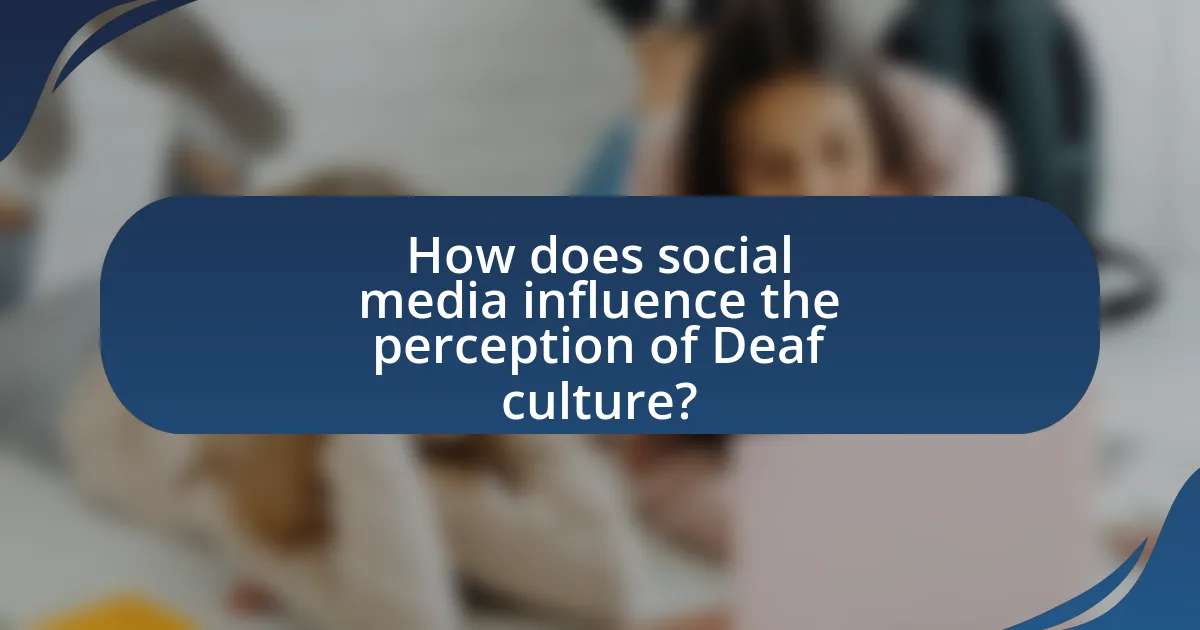
How does social media influence the perception of Deaf culture?
Social media significantly influences the perception of Deaf culture by providing a platform for visibility and representation. Through platforms like Instagram, TikTok, and YouTube, Deaf individuals can share their experiences, language, and culture, fostering a sense of community and awareness among both Deaf and hearing audiences. Research indicates that social media campaigns, such as #DeafTalent, have successfully highlighted the achievements of Deaf individuals in various fields, challenging stereotypes and promoting inclusivity. This increased visibility helps to reshape societal perceptions, making Deaf culture more recognized and respected.
What role does social media play in educating the public about Deaf culture?
Social media plays a crucial role in educating the public about Deaf culture by providing a platform for Deaf individuals to share their experiences, language, and traditions. Through various social media channels, Deaf creators can disseminate information, challenge misconceptions, and promote awareness about their culture, leading to greater understanding among hearing audiences. For instance, platforms like Instagram and TikTok have seen a rise in content created by Deaf influencers who use sign language and visual storytelling to engage viewers, thereby increasing visibility and representation of Deaf culture. This engagement is supported by statistics showing that 90% of Deaf individuals use social media, making it an effective tool for cultural education and advocacy.
How do social media platforms facilitate cultural exchange among Deaf individuals?
Social media platforms facilitate cultural exchange among Deaf individuals by providing accessible spaces for communication, sharing experiences, and promoting Deaf culture. These platforms enable Deaf users to connect globally, share videos in sign language, and participate in discussions that highlight their unique cultural identity. For instance, platforms like Facebook and Instagram allow users to post content that showcases Deaf art, storytelling, and advocacy, fostering a sense of community and belonging. Additionally, research indicates that social media serves as a vital tool for information dissemination within the Deaf community, enhancing awareness of cultural events and resources, which further strengthens cultural ties and exchanges.
What are the challenges faced in representing Deaf culture on social media?
Representing Deaf culture on social media faces several challenges, including accessibility, misrepresentation, and lack of understanding. Accessibility issues arise when content is not designed with Deaf users in mind, such as the absence of captions or sign language interpretation, which limits engagement. Misrepresentation occurs when non-Deaf individuals portray Deaf experiences inaccurately, leading to stereotypes and misconceptions. Additionally, a general lack of understanding about Deaf culture among the broader public can result in content that fails to resonate or connect authentically with Deaf audiences. These challenges hinder the effective amplification of Deaf voices and innovations on social media platforms.
How can social media foster community among Deaf individuals?
Social media can foster community among Deaf individuals by providing platforms for connection, communication, and shared experiences. These platforms enable Deaf individuals to engage with one another through visual content, such as videos and images, which are more accessible than text-based communication. Research indicates that social media groups and pages specifically for Deaf individuals facilitate the sharing of resources, information, and support, thereby enhancing a sense of belonging and community. For instance, a study published in the Journal of Deaf Studies and Deaf Education highlights that online communities significantly improve social interaction and emotional support among Deaf individuals, demonstrating the positive impact of social media in creating inclusive environments.
What online communities exist for Deaf individuals on social media?
Online communities for Deaf individuals on social media include platforms such as Facebook groups, Instagram pages, and Twitter hashtags specifically designed for Deaf culture and advocacy. For example, the Facebook group “Deaf Community” connects members for sharing experiences and resources, while Instagram accounts like @deafworld showcase Deaf artists and influencers. Additionally, Twitter hashtags such as #DeafTwitter facilitate discussions and networking among Deaf individuals. These communities provide a space for sharing information, fostering connections, and amplifying Deaf voices in a digital environment.
How do these communities support and empower Deaf voices?
Deaf communities support and empower Deaf voices through advocacy, education, and the use of social media platforms. These communities create spaces for Deaf individuals to share their experiences, promote awareness, and foster a sense of belonging. For instance, organizations like the National Association of the Deaf utilize social media to disseminate information about Deaf culture and rights, thereby amplifying Deaf perspectives. Additionally, social media campaigns often highlight Deaf artists, educators, and activists, showcasing their contributions and encouraging engagement. This visibility not only empowers individuals but also challenges societal misconceptions about Deafness, reinforcing the importance of inclusive representation.
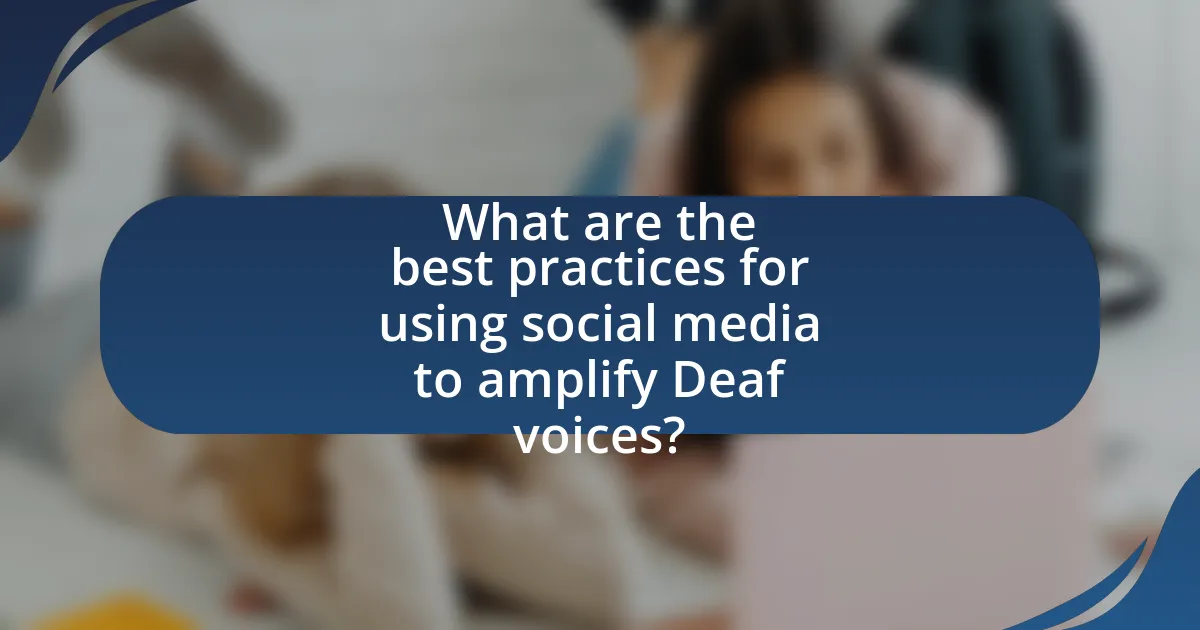
What are the best practices for using social media to amplify Deaf voices?
To amplify Deaf voices on social media, it is essential to prioritize accessibility, representation, and community engagement. Accessibility can be achieved by using captions, sign language interpretation, and visual content to ensure that Deaf individuals can fully engage with the material. Representation involves showcasing diverse Deaf voices and experiences, which can help to challenge stereotypes and promote understanding. Community engagement is crucial; actively involving Deaf individuals in content creation and decision-making processes fosters a sense of ownership and authenticity. Research indicates that inclusive practices on social media can significantly enhance visibility and support for marginalized communities, including the Deaf community.
How can individuals effectively share their stories on social media?
Individuals can effectively share their stories on social media by utilizing engaging visuals, authentic narratives, and targeted hashtags. Engaging visuals, such as photos and videos, capture attention and enhance storytelling, as studies show that posts with images receive 94% more views than text-only posts. Authentic narratives resonate with audiences, fostering emotional connections; research indicates that personal stories can increase engagement by up to 300%. Targeted hashtags improve discoverability, allowing stories to reach wider audiences interested in specific topics, which is crucial for amplifying underrepresented voices, such as those in the Deaf community.
What strategies can be employed to engage a wider audience?
To engage a wider audience, leveraging social media platforms is essential. Social media allows for targeted outreach, enabling content to reach specific demographics, including the deaf community. For instance, using visual storytelling through videos and infographics can effectively communicate messages, as studies show that visual content is 40 times more likely to be shared than other types of content. Additionally, collaborating with influencers within the deaf community can amplify reach, as their established trust can attract more followers. Engaging in interactive content, such as live Q&A sessions or polls, fosters community involvement and encourages participation. These strategies are supported by data indicating that interactive posts generate 6 times more engagement than static posts.
How can visual content enhance storytelling for Deaf individuals?
Visual content enhances storytelling for Deaf individuals by providing a rich, accessible medium that conveys information through imagery, graphics, and sign language. This approach allows Deaf individuals to engage with narratives in a way that aligns with their preferred modes of communication, facilitating understanding and emotional connection. Research indicates that visual storytelling can improve comprehension and retention of information, as seen in studies where visual aids significantly increased engagement levels among Deaf audiences. By utilizing platforms like social media, creators can share visually-driven stories that resonate with Deaf individuals, fostering a sense of community and representation.
What tools and resources are available for Deaf individuals on social media?
Deaf individuals have access to various tools and resources on social media that enhance communication and engagement. These include video relay services (VRS) and video remote interpreting (VRI), which facilitate real-time communication through sign language interpreters. Additionally, social media platforms like Facebook, Instagram, and TikTok offer features such as closed captioning and live streaming, allowing Deaf users to share content and connect with others effectively. Research indicates that these tools significantly improve social interaction and community building among Deaf individuals, as they can express themselves visually and access information in accessible formats.
Which platforms are most accessible for Deaf users?
YouTube and Facebook are the most accessible platforms for Deaf users. YouTube offers a vast array of content with closed captioning options, allowing Deaf users to engage with videos easily. Facebook supports video content with captions and has a strong community aspect, enabling Deaf users to connect and share experiences. Research indicates that platforms with robust accessibility features, such as captioning and visual content, significantly enhance user engagement for Deaf individuals.
How can Deaf individuals leverage hashtags and trends to increase visibility?
Deaf individuals can leverage hashtags and trends to increase visibility by strategically using relevant hashtags that resonate with their community and current social media trends. By incorporating popular hashtags related to Deaf culture, advocacy, and trending topics, they can enhance their content’s reach and engagement. For instance, using hashtags like #DeafAwareness or #DeafCommunity can connect them with a broader audience interested in Deaf issues. Additionally, participating in trending challenges or discussions on platforms like Twitter and Instagram can further amplify their voices, as these trends often attract significant attention and interaction. Research indicates that posts with relevant hashtags can increase engagement by up to 12.6% on Instagram, demonstrating the effectiveness of this strategy in gaining visibility.
What common pitfalls should Deaf individuals avoid on social media?
Deaf individuals should avoid miscommunication and assumptions about their communication preferences on social media. Miscommunication can arise from the use of unclear language or lack of context in posts, which may lead to misunderstandings. Additionally, assuming that all Deaf individuals prefer the same mode of communication, such as sign language or text, can alienate some users. Research indicates that 90% of Deaf individuals use social media to connect with others, highlighting the importance of clear communication strategies tailored to diverse preferences.
